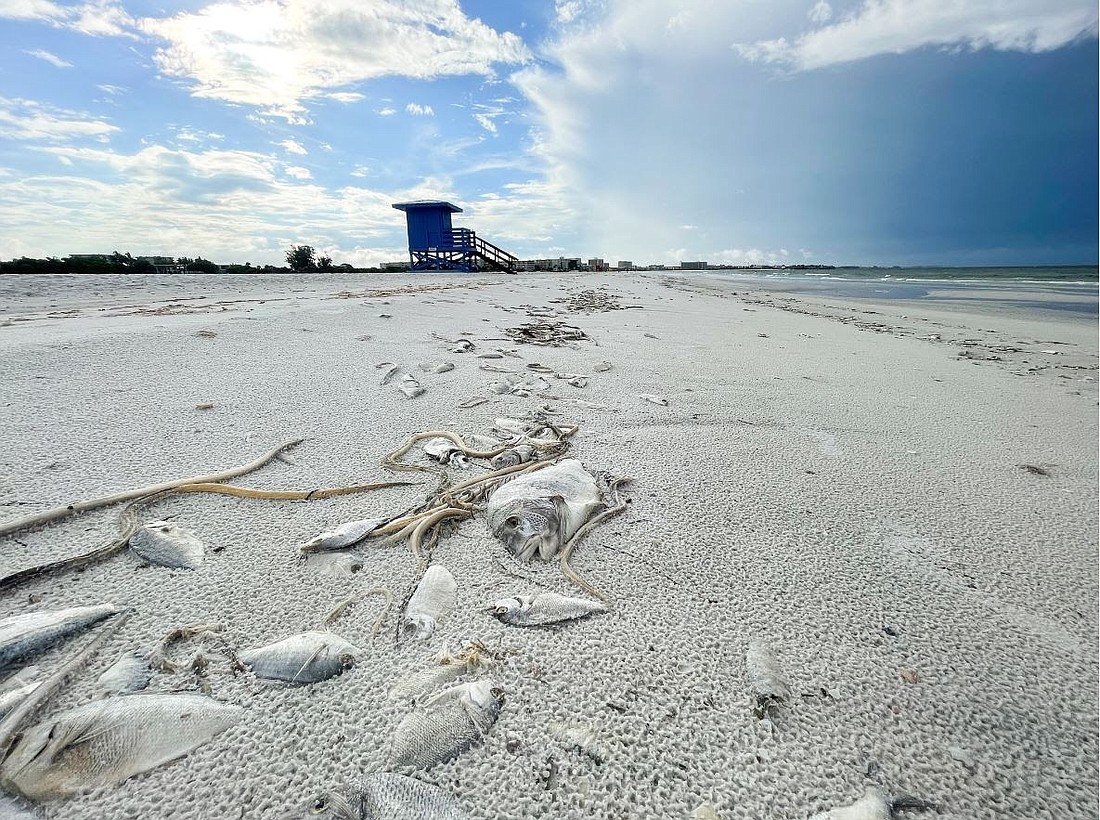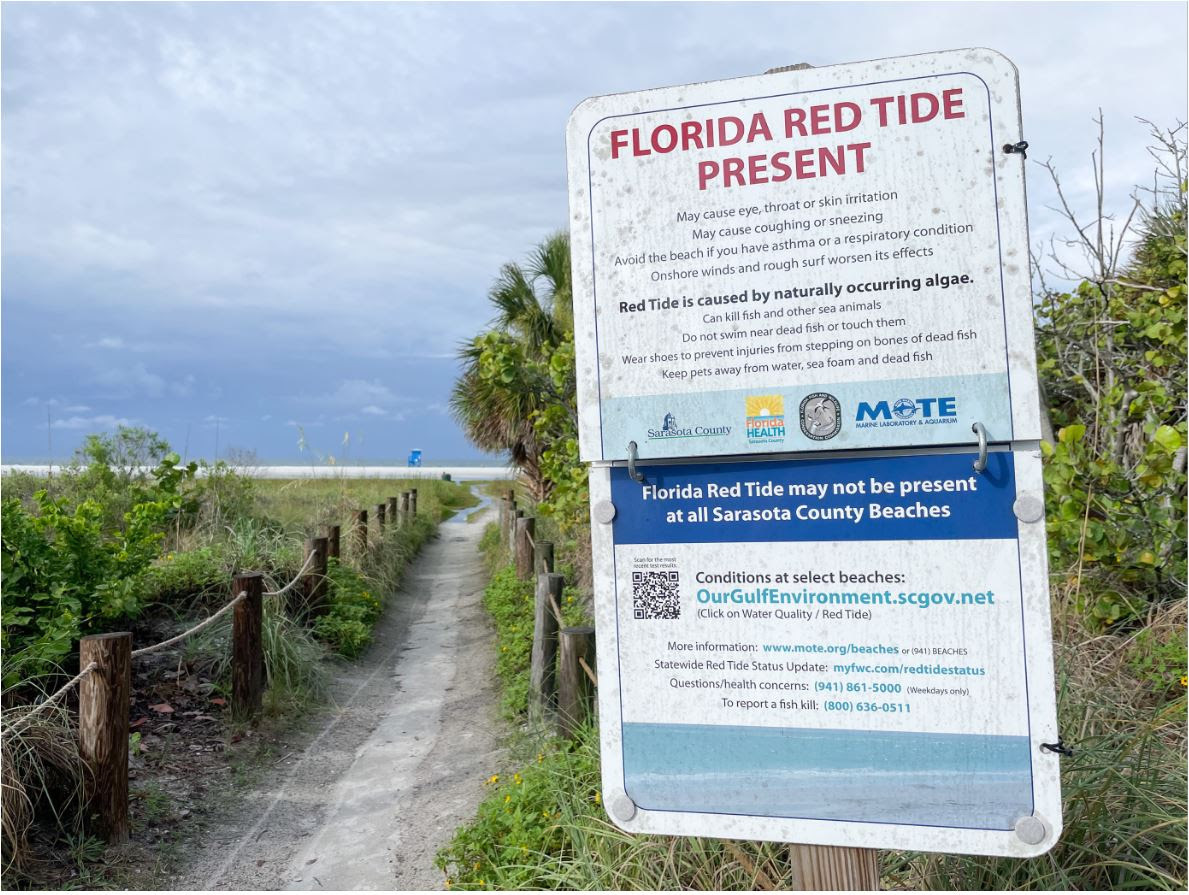- April 4, 2025
-
-
Loading

Loading

Sarasota stinks.
At least, portions of the area have been subject to a foul odor, an unpleasant byproduct of a red tide bloom that’s had varying effects on the county in the past several weeks. In the past few days, anecdotal reports indicate those effects have become more wide-ranging, with the smell wafting from the coasts well into the mainland.
Red tide isn’t an uncommon phenomenon in Sarasota, but each bloom has its own distinct dynamics. What distinguishes this year from red tides past? Some residents have pointed to the smell as one defining factor.
“Everywhere you walk outside your door, it smells like really old ripe garbage,” said Catherine Luckner, the president of the Siesta Key Association.
It’s not just a standalone stench, either. Red tide has detrimental effects on the respiratory system and irritates the eyes, and that’s been noticeable recently, too, said Carl Shoffstall, the president of the Lido Key Resident Association.
“The smell and the burning of the eyes are pretty rough right now,” Shoffstall said.
One related red tide side effect is an accumulation of dead fish in waterways and along the shores. Residents have raised questions and issued complaints about the county’s strategy for cleaning up those dead fish — or, as has been the more common point of contention, for declining to clear the beaches of marine debris.
“Why is there not a steady daily check on getting this cleaned off the beaches if we can?” Luckner said.
On Wednesday, the county mobilized its beach cleanup operations for the first time, allowing mechanical clearing and hand-picking of debris along public shorelines.
Why didn’t this beach sanitation start sooner? Nicole Rissler, the county’s director of Parks, Recreation and Natural Resources, cited two reasons at a news conference Wednesday. One, the county said it was abiding by its adopted beach cleanup policy, which only calls for a cleaning when there’s enough accumulated debris to fill a 5-yard truck per 2-mile section of beach — and only if two tidal cycles have not removed the debris. Until Wednesday, Rissler said the county hadn’t hit that mark and did not deviate from the established protocol.
“We like Mother Nature to help us, and that’s where that beach cleaning policy comes in,” Rissler said.
The second factor is that Rissler said staff had been awaiting confirmation from the Florida Department of Environmental Protection that the county had the necessary permits to proceed with pickup operations, which also just recently came in. Rissler said the county has the authority for general beach cleanup for maintenance purposes, but in previous years, the red tide response effort was aided in part by the declaration of a state of emergency. Without such an order coming from the governor’s office, Rissler said officials wanted to communicate with the DEP and the Florida Fish and Wildlife Conservation Commission to ensure they were in the clear to bring machinery onto the beach.
The county’s cleanup operations have drawn the ire of some residents who say the dead fish are a major contributor to the detrimental effects of red tide — and a source of nutrients that could sustain the naturally occurring phenomenon. In a July 16 email to county officials, Longboat Key resident Doreen Dupont asked why officials had not cleaned out fish in a canal by her home, and said the smell as overwhelming.
County Administrator Jonathan Lewis responded that it was not Sarasota’s policy to clear canals in response to fish kills.
“It is not practical or financially feasible to try and remove the fish,” Lewis said in the email. “The combination of the tides and the fish sinking are usually a timelier resolution within our canals.”

As some members of the public groused about a lack of cleanup, the city of Sarasota prepared to mobilize its own response to red tide in coastal areas. In mid-July, city leaders inquired about the policy for cleaning up canals and other waterways not under county control. Staff responded that the city had existing contracts with debris management companies if necessary, but they noted the city had not cleaned canals during the more severe red tide bloom of 2018. Public Works Director Doug Jeffcoat also noted the absence of a state of emergency would also require the city to take on the costs associated with cleanup itself.
Still, by July 28, City Manager Marlon Brown said he wanted a plan in place to clean areas on Lido Key if the county did not do so.
“This is a quality-of-life issue that we need to uphold as one of our top priorities,” Brown said in an email to other officials. “I understand that this may result in a temporary reallocation of much needed resources, but we will have to handle accordingly.”
So far, the city hasn’t yet conducted a cleanup, spokesperson Jason Bartolone said. Still, staff is regularly monitoring conditions in canals and waterways, visiting 17 sites on Monday to evaluate the effects of red tide in that area. On Tuesday, City Commissioner Jen Ahearn-Koch announced her intent to organize a community town hall for a bigger-picture discussion on red tide and the region’s aquatic environment.
Rissler affirmed the individual accounts that suggested this year’s red tide is having a more variable impact on Sarasota. Every day, the county updates a matrix on its online red tide dashboard that details the conditions at nine county beaches. The report assesses the status of fish kills, seaweed accumulation and aerosol effects at each beach.
Those effects can behave independently of one another: On Wednesday, there were minor reports of dead fish on seven of the nine county beaches, but there were moderate to major aerosol issues at every single beach. This presents a different challenge than the 2018 red tide — one that’s less severe but requires daily vigilance to ensure an effective response.
“In 2018, we were bombarded, and it didn’t matter what beach; we were doing cleanup everywhere,” Rissler said. “In this, it’s kind of come and gone in the past couple of months and weeks.”